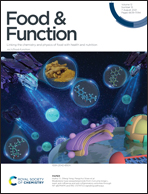Capsaicin stability and bio-accessibility affected by complexation with high-amylose corn starch (HACS)†
Abstract
Delivery of pungent bioactives such as capsaicin from hot peppers is a scientific, technological and sensorial challenge. While capsaicin intake is positively related to various bowel diseases, its high pungency and instability upon digestion generate a problem in its delivery to the target organ. Helical V-amylose architectures have been shown to be a possible nano-sized delivery vehicle for such hydrophobic bioactives. This study sought to entrap capsaicin (CAP) within high amylose corn starch (HACS), quantitate and optimize the encapsulation efficiency and other techno-functional properties as well as evaluate the release of capsaicin in the duodenum. By adapting an acidification protocol, HACS was processed to form nanocapsules loaded with capsaicin. The capsaicin content and loading ratio were optimized to 44.0% (±0.4) and 1 : 1 (CAP : HACS, w/w), respectively. AFM and XRD measurements of the complexes confirmed the formed nanocapsules to be V-type crystals with a 1 : 10 (CAP : HACS, w/w) loading ratio showing the highest level of crystallinity. Laser scattering measurements demonstrated an increase in poly-dispersity as the loading ratio increased as well as a higher surface-area diameter. Scanning electron microscopy (SEM) revealed the formation of irregular circular starch inclusion complexes upon acidification treatment. Finally, an in vitro digestion model was utilized to ascertain capsaicin release under gastro-intestinal conditions that coincides with complex degradation under digestive conditions. Both adult and elderly in vitro digestion models were applied, showing the effect of age on the nanocapsule degradation and capsaicin bioaccessibility. Overall, this work provides practical information about the use of HACS for nano-encapsulation of capsaicin and its controlled release under digestive conditions, and provides insight regarding the correlation between nanocomplex characteristics and the consumer physiology. Such a nano-encapsulation platform could prove to be useful in the fortification and supplementation of starchy foods with challenging bioactives, such as the pungent capsaicin.



 Please wait while we load your content...
Please wait while we load your content...